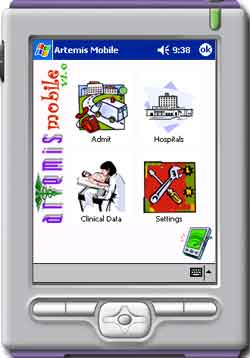Building interoperability into medical information

Graphical interface of the Artemis mobile application used in ambulance
Modern health information systems today are proprietary and often only serve one department making it impossible to easily share data across one facility, never mind across different facilities or countries. A big problem, it makes it difficult for doctors to capture a complete clinical history of a patient. But one project hopes to overcome this.
“The healthcare interoperability problem can be investigated in two categories: Interoperability of the healthcare messages exchanged and interoperability of electronic healthcare records [EHRs],” says Professor Asuman Dogac, Director of the Software Research & Development Center in Turkey, and ARTEMIS project coordinator.
Right now messaging interfaces, or interface engines, are used to exchange information among different healthcare information systems. Currently, the Health Level 7 (HL7) Version 2 Messaging Standard is the most widely implemented.
Unfortunately, HL7 V2 compliance does not imply direct interoperability between healthcare systems, because V2 has no explicit information model. Instead it has rather vague definitions for many data fields and contains many optional fields.
EHRs suffer from similar problems. An EHR is digitally stored healthcare information about an individual that supports continuity of care, education and research, while ensuring confidentiality. A number of standardisation efforts are progressing to provide EHRs interoperability. However, an exchange of well-structured and machine-processable EHRs has not been achieved yet in practice.
ARTEMIS provides the desperately required interoperability between medical information systems through semantically-enriched Web services that use defined meanings of individual pieces of parameters. ARTEMIS uses existing standards, such as HL7, as a basis for defining both the service action semantics and the message semantics.
For EHRs, ARTEMIS uses constraint rules for specific clinical concepts, called ‘archetypes’, rather than distinct entities in the reference information model. It annotates their archetypes with ontologies, an established list of definitions, and then composes templates from archetypes and retrieves corresponding data from the underlying medical information systems.
To complicate matters, in most countries there are no unique person identifiers that would be valid for the whole lifetime of an individual and used by all parties in healthcare and for all episodes of care. In many cases several identifiers for a patient exist even within a single organisation.
Consequently a protocol is needed that allows the identification of patients by means of non-unique patient-related attributes. ARTEMIS developed a ‘Patient Identification Process’ (PIP) Protocol’. PIP provides a solution for continuity of care by locating and accessing prior clinical records and provides comprehensive security and privacy protection mechanisms.
Currently, the industry’s Integrating the Healthcare Enterprise (IHE) initiative proposes the Retrieve Information for Display (RID) integration profile to allow users retrieve and display patient-related documents on systems other than the document keeping systems. Although it is well suited for use in a single hospital or within a trust of hospitals that belong to a single Patient Identifier Domain, it is not designed for cross-boundary access on information stored in different hospitals.
ARTEMIS’ middleware infrastructure extends the IHE RID protocol for cross-enterprise search and access to patient-related clinical information, even if no Master Patient Index is available, and without modifications to existing information source actors. Applied to the ARTEMIS infrastructure, the RID Information Source and Display actors may be located in different institutions using different Patient ID domains and different sets of demographic data.
At the Healthcare Information and Management Systems Society annual conference in San Diego, February 2006, “we will run a demonstrator that will realise a scenario where, after an accident, a patient is admitted to the most appropriate hospital from the ambulance,” says Dr Dogac. “The patient will be admitted before the ambulance arrives at the hospital, via a mobile device. The hospital admissions service will then automatically seek out any relevant healthcare records of the patient in the ARTEMIS P2P network, and presents them to the doctor, although the hospitals discovered may not be using interoperable standards with each other. This is a considerable improvement over current systems.”
Dr Dogac will begin a new project, SAPHIRE, in the next months. “That project will seek to extend the functionality of ARTEMIS. It will expose medical sensor data as semantically-enriched Web services. It will process sensor output, the patient’s medical history and clinical guidelines to help physicians with diagnoses and treatment.”
But even without these new services, ARTEMIS already represents a major advance; it enables clinicians to capture the complete clinical history of a patient that may be spread out over a number of different institutes that do not interoperate.
Media Contact
More Information:
http://istresults.cordis.lu/All latest news from the category: Information Technology
Here you can find a summary of innovations in the fields of information and data processing and up-to-date developments on IT equipment and hardware.
This area covers topics such as IT services, IT architectures, IT management and telecommunications.
Newest articles

A universal framework for spatial biology
SpatialData is a freely accessible tool to unify and integrate data from different omics technologies accounting for spatial information, which can provide holistic insights into health and disease. Biological processes…

How complex biological processes arise
A $20 million grant from the U.S. National Science Foundation (NSF) will support the establishment and operation of the National Synthesis Center for Emergence in the Molecular and Cellular Sciences (NCEMS) at…

Airborne single-photon lidar system achieves high-resolution 3D imaging
Compact, low-power system opens doors for photon-efficient drone and satellite-based environmental monitoring and mapping. Researchers have developed a compact and lightweight single-photon airborne lidar system that can acquire high-resolution 3D…





















